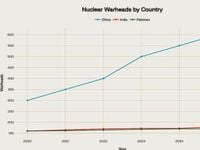In the shifting landscape of global nuclear power, South Asia finds itself at the center of a tense and rapidly evolving standoff. As of November 16, 2025, the credibility of India’s and Pakistan’s nuclear deterrents is under intense scrutiny, with new pressures reshaping old doctrines and raising urgent questions about security, stability, and the future of the region.
For decades, the strategic balance in South Asia rested on a delicate equilibrium. India’s 1998 Pokhran-II tests marked its arrival as a declared nuclear-weapon state, underpinned by a doctrine of “Credible Minimum Deterrence” and a public pledge of “No First Use” (NFU). This stance was designed to assure both restraint and sovereignty, signaling that India would not be the first to use nuclear weapons under any circumstances. According to the Stockholm International Peace Research Institute (SIPRI), India’s arsenal today stands at around 180 warheads.
But the world India faces in 2025 is dramatically different from the one it confronted in 1998. As Hindol Sengupta, professor of international relations at O. P. Jindal Global University, notes, "The strategic realities of 2025 are not those of 1998. The ‘minimum’ is no longer ‘credible’ when faced with China’s ‘massive’ and Pakistan’s ‘full spectrum.’"
The most pressing challenge comes from China’s nuclear breakout. According to SIPRI’s January 2025 estimates, China’s arsenal has ballooned to 600 warheads—an increase of 100 in just one year—with forecasts suggesting this number could soar past 1,000 by 2030. China is constructing over 350 new missile silos for advanced solid-fuel intercontinental ballistic missiles (ICBMs) like the DF-41, which can carry multiple independently-targetable re-entry vehicles (MIRVs). Its nuclear triad is now robust, featuring at least six Type 094 (Jin-class) nuclear-powered ballistic missile submarines armed with long-range JL-3 submarine-launched ballistic missiles (SLBMs), and long-range H-6N bombers capable of delivering air-launched ballistic missiles.
What’s more, there are signs that China may be shifting from a longstanding “No First Use” posture to a “Launch on Warning” stance—meaning it could launch its nuclear missiles upon detecting an incoming attack, rather than waiting for a strike to land. This shift, while not officially confirmed, would fundamentally alter the region’s strategic calculus. As Sengupta asks, "How can a ‘minimum’ deterrent of 180 warheads, maintained at a lower state of readiness, ‘credibly’ threaten a nation with 600 (and soon 1,000) warheads, advanced missile defences, and a LOW posture?"
India’s planners now face a daunting dilemma: their doctrine of assured retaliation, which relies on the threat of a devastating response to any nuclear attack, may no longer be credible against China’s rapidly expanding and increasingly sophisticated arsenal. The logic of “Credible Minimum Deterrence” is coming under strain, and the need for a sober re-examination of doctrine and force structure is growing more urgent by the day.
On India’s western frontier, Pakistan presents a different, yet equally vexing, challenge. With a nuclear stockpile estimated at 170 warheads, Pakistan has adopted a doctrine of “Full Spectrum Deterrence.” This includes the development and deployment of tactical nuclear weapons (TNWs), such as the short-range Nasr missile (with a 60-70 km range), specifically designed for use against Indian troop formations. The doctrine is explicit: Pakistan reserves the right to use nuclear weapons first, particularly to counter India’s conventional military superiority.
This approach creates what analysts call a “crisis of credibility” for India’s doctrine of massive retaliation. If Pakistan were to use a single, low-yield TNW against advancing Indian forces, would India really respond with a strategic nuclear strike against a major Pakistani city? The international fallout, risk of escalation, and moral calculus make such a response seem unlikely. Yet, if India does not respond massively, its deterrent fails, and Pakistan succeeds in using nuclear weapons to win a conventional conflict. This “doctrinal squeeze” leaves India caught between a rock and a hard place—between the massive, strategic overmatch of China and the tactical, low-threshold challenge from Pakistan.
India has made significant technological strides in recent years. Its nuclear triad is now functional, with the INS Arihant and INS Arighaat submarines providing second-strike capability. However, these submarines are currently armed with shorter-range K-15 missiles, limiting their operational reach. The longer-range K-4 missile, still under testing, is urgently needed to allow these assets to patrol deeper waters and remain survivable. Meanwhile, the successful “Mission Divyastra” test demonstrated India’s ability to deploy MIRVs on the Agni-V missile—a potential game-changer in terms of striking multiple targets and overwhelming missile defenses.
Yet, as Sengupta points out, "These achievements, while necessary, are no longer sufficient." China’s arsenal is growing at a pace that outstrips India’s incremental advances. The Arihant-class submarines, while a milestone, are not enough on their own to guarantee survivability against a determined adversary with vastly superior numbers and technological sophistication.
Pakistan, for its part, faces its own set of challenges regarding the safety and security of its nuclear arsenal. According to recent assessments, Pakistan’s nuclear command is overseen by the National Command Authority, which brings together military, civilian, and scientific leaders. Islamabad insists its weapons are stored disassembled and protected by sophisticated systems. However, independent observers highlight vulnerabilities—including insider threats, political instability, and the persistent activity of militant groups such as Tehreek-e-Taliban Pakistan, which has demonstrated the ability to penetrate sensitive areas.
The unstable Durand Line, which separates Pakistan and Afghanistan, remains a hotbed of militant activity and cross-border sanctuaries. Pakistan’s inconsistent approach to various militant factions—some of which have been accused of exporting terror to neighboring Jammu and Kashmir—fuels international concern over the security of its nuclear assets. Political instability, frequent leadership changes, and economic crises further erode the state’s capacity to maintain robust command and control. Unlike major nuclear powers, Pakistan’s financial constraints make it difficult to invest continuously in the latest security technologies.
Compounding these concerns is Pakistan’s status outside the Nuclear Non-Proliferation Treaty (NPT) framework, which means it is not subject to the full spectrum of international safety obligations. While Pakistan has participated in some cooperative mechanisms, the lack of comprehensive oversight continues to worry the global community. As one analysis put it, "The true measure of a nuclear power is not the size of its arsenal but the credibility of its safety framework. For Pakistan, building such credibility remains an urgent and unfinished task."
What, then, is the way forward for both countries? Experts recommend that Pakistan strengthen internal security, eliminate extremist sanctuaries, establish transparent civilian oversight, modernize physical protection systems, and commit to international standards. For India, the time has come to urgently recalibrate its arsenal size and structure, move beyond mere “minimum” numbers, and ensure that its deterrent remains credible in the face of evolving threats. This might mean raising the arsenal to 200-250 warheads by 2030, deploying more MIRV-equipped missiles, and investing in more robust, survivable command and control systems. Both nations must walk a tightrope—bolstering their capabilities without triggering an arms race that could destabilize the entire region.
In the end, the question is not just about how many warheads a country possesses, but how securely they are managed and how credibly they deter adversaries in a world where the nuclear landscape is shifting faster than ever before.




